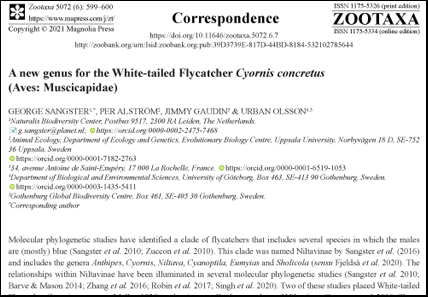Ng, E. Y. X., Li, S., Zhang, D., Garg, K. M., Song, G., Martinez, J., Hung, L. M., Tu, V. T., Fuchs, J., Dong, L., Olsson, U., Huang, Y., Alström, P., Rheindt, F. E., & Lei, F. (2022). Genome-wide SNPs confirm plumage polymorphism and hybridisation within a
Cyornis flycatcher species complex.
Zoologica Scripta, 00, 1– 16.
https://doi.org/10.1111/zsc.12568
Morphology has been a leading taxonomic guiding light to systematists for the last couple of hundred years. However, the genetic and – more recently – genomic revolution have produced numerous demonstrations of erroneous classifications that were based on labile morphological traits. We used thousands of genome-wide markers to shed light on evolutionary dynamics in a confusing and taxonomically obscure group of Asian
Cyornis flycatchers. Using genomic data, we corroborated recent findings based on three mitochrondrial and five nuclear genes that the two taxa
hainanus and
klossi which were previously treated as separate species (
Cyornis hainanus and
Cyornis rubeculoides klossi, respectively) are genomically homogeneous and form a single species,
C. hainanus. We also uncovered a novel case of interbreeding between
C. hainanus and a non-sister species,
C. glaucicomans, illustrating these flycatchers' ability to hybridise in marginal situations even after substantial times of divergence. Our study illustrates how genome-wide loci can shed light on complicated taxonomic problems, resulting in a better integration of phenotypic and genotypic data.








